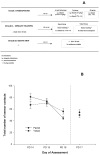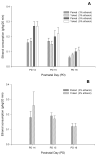Motivational effects of intraorally-infused ethanol in rat pups in an operant self-administration task
- PMID: 17854847
- PMCID: PMC2262933
- DOI: 10.1016/j.physbeh.2007.08.004
Motivational effects of intraorally-infused ethanol in rat pups in an operant self-administration task
Abstract
Motivational effects of self-administered ethanol have rarely been studied in preweanling rats due primarily to the lack of age-appropriate operant tasks. The present experiments assessed the hedonic effects of intraoral ethanol in infant rats self-administered by activating a touch sensor. On postnatal day (PD) 13 pups were pre-exposed to the drug's pharmacological and/or sensory effects. Operant sessions were conducted during PDs 14-16 (Experiments 1 and 2). Paired animals were placed in chambers equipped with a touch-sensitive disk and received an intraoral infusion of ethanol (3 or 5% v/v, 5 microl) after each sensor contact. Yoked controls were equated for number and distribution of ethanol infusions but had no control over the contingency between operant behavior and intraoral infusion. In Experiment 2, training trials were preceded by a non-reinforced phase. Paired pups performed fewer operant responses than controls and decreased their operant responses across sessions. These results suggest that intraoral self-administered ethanol has an aversive hedonic value in two-week old rats. Operant behavior seems to have been associated with aversive orosensory effects derived from intraoral ethanol infusion.
Figures





Similar articles
-
Role of mu, delta and kappa opioid receptors in ethanol-reinforced operant responding in infant rats.Behav Brain Res. 2012 Oct 1;234(2):267-77. doi: 10.1016/j.bbr.2012.07.002. Epub 2012 Jul 10. Behav Brain Res. 2012. PMID: 22789403 Free PMC article.
-
Infant rats exhibit aversive learning mediated by ethanol's orosensory effects but are positively reinforced by ethanol's post-ingestive effects.Pharmacol Biochem Behav. 2008 Feb;88(4):393-402. doi: 10.1016/j.pbb.2007.09.012. Epub 2007 Sep 20. Pharmacol Biochem Behav. 2008. PMID: 17936347 Free PMC article.
-
Prenatal exposure to ethanol during late gestation facilitates operant self-administration of the drug in 5-day-old rats.Alcohol. 2014 Feb;48(1):19-23. doi: 10.1016/j.alcohol.2013.11.001. Epub 2013 Nov 25. Alcohol. 2014. PMID: 24355072 Free PMC article.
-
Operant self-administration of ethanol in infant rats.Physiol Behav. 2015 Sep 1;148:87-99. doi: 10.1016/j.physbeh.2014.08.002. Epub 2014 Aug 30. Physiol Behav. 2015. PMID: 25178678 Review.
-
Assessing appetitive, aversive, and negative ethanol-mediated reinforcement through an immature rat model.Neurosci Biobehav Rev. 2009 Jun;33(6):953-74. doi: 10.1016/j.neubiorev.2009.03.008. Epub 2009 Mar 24. Neurosci Biobehav Rev. 2009. PMID: 19428502 Free PMC article. Review.
Cited by
-
Fetal Alcohol Programming of Subsequent Alcohol Affinity: A Review Based on Preclinical, Clinical and Epidemiological Studies.Front Behav Neurosci. 2020 Mar 10;14:33. doi: 10.3389/fnbeh.2020.00033. eCollection 2020. Front Behav Neurosci. 2020. PMID: 32210775 Free PMC article. Review.
-
Role of mu, delta and kappa opioid receptors in ethanol-reinforced operant responding in infant rats.Behav Brain Res. 2012 Oct 1;234(2):267-77. doi: 10.1016/j.bbr.2012.07.002. Epub 2012 Jul 10. Behav Brain Res. 2012. PMID: 22789403 Free PMC article.
-
Alcohol self-administration, anxiety, and cortisol levels predict changes in delta opioid receptor function in the ventral tegmental area.Behav Neurosci. 2012 Aug;126(4):515-22. doi: 10.1037/a0029027. Epub 2012 Jun 18. Behav Neurosci. 2012. PMID: 22708955 Free PMC article.
-
Prenatal ethanol increases sucrose reinforcement, an effect strengthened by postnatal association of ethanol and sucrose.Alcohol. 2014 Feb;48(1):25-33. doi: 10.1016/j.alcohol.2013.11.003. Epub 2013 Dec 12. Alcohol. 2014. PMID: 24398347 Free PMC article.
-
Ethanol-mediated operant learning in the infant rat leads to increased ethanol intake during adolescence.Pharmacol Biochem Behav. 2008 Oct;90(4):640-50. doi: 10.1016/j.pbb.2008.05.007. Pharmacol Biochem Behav. 2008. PMID: 18571224 Free PMC article.
References
-
- Cunningham CL, Niehus JS, Noble D. Species difference in sensitivity to to ethanol's hedonic effects. Alcohol. 1993;10:97–102. - PubMed
-
- Cicocciopo R, Panocka I, Froldi R, Quitadamo E, Mazzi M. Ethanol induces conditioned place preference in genetically selected alcohol-preferring rats. Psychopharmacology. 1999;141:235–241. - PubMed
-
- Deems DA, Oetting RL, Sherman JE, Garcia J. Hungry, but not thirsty, rats prefer flavors paired with ethanol. Physiol Behav. 1986;36:141–4. - PubMed
-
- Cunningham CL, Hawks D, Niehus D. Role of hypothermia in ethanol-induced conditioned taste aversion. Psychopharmacology. 1988;95:318–322. - PubMed
Publication types
MeSH terms
Substances
Grants and funding
LinkOut - more resources
Full Text Sources
Miscellaneous

